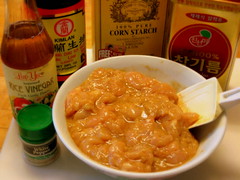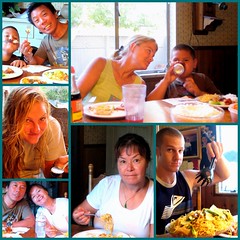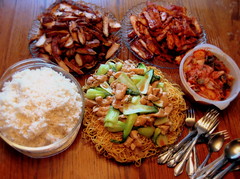As I am now a wife and mother, I enjoy cooking for my family and friends. It gives me an immense amount of pride and undeniable joy that I can nourish their bodies with my cooking and minds with conversation around my dining table. To me, there is nothing better.
My husband enlisted in the Navy a couple months ago and is on delayed entry because of the overwhelming amount of new recruits, so he will not be leaving for boot camp and A-training until February of next year. We will not know where we will be stationed until after he returns, though it seems fairly certain we will not be staying in San Diego. It is somewhat exciting, but scary at the same time because our families have never been far and neither of us have lived outside of San Diego. Knowing that we more than likely not be staying here has made me think of what I might be leaving behind: my family's cooking.
I come from a family that has always centered around the kitchen. Both of my parents cook, my grandparents cooked, my aunts and uncles cook. I am of Chinese, Korean, and Italian decent so there has always been an abundance of different cuisines rotating through my family's kitchen for as long as I can remember. Before I continue, let me say...I am an odd Asian girl...I do not really prefer rice as much as I prefer pasta. When I was younger I used to get very burnt out on Asian food, but now that I have a family and house of my own, I find that sometimes I crave it. My mother, her mother, and her sisters have always made amazing Korean food. My father and his mother have always made amazing Chinese food. And me...well...I never made a good, let alone amazing, dish from either cuisine until today...
I had never really thought about learning to cook either Chinese or Korean food because I have always had my parents/grandparents around to make it for me if I desired. However, a few years ago my grandmother on my father's side passed away from cancer and suddenly a lot of the Chinese food I had grown accustomed to was no longer around. Sure I could go to a restaurant, but it was not the same. It was not my grandmother's. I think about a year ago my father was going through what I am going through now...trying to learn the family's recipes so you could still have a taste of what once was. My father started noticing all the things that my grandmother used to cook that he had never really took the time to learn to make himself that now was not there. So he took to trying to go through her old handwritten notes of what recipes she did write down (highly embellished and personally flourished as most Asian cooks usually do) and scouring the internet for the ones he could not find. I suddenly realized a couple weeks ago that if/when we move there might come a day where I would want some of my parents' cooking and they would not be around to make it for me. I needed to learn. Not only for myself, but for my family. So we all could retain the closeness that food brings, whether we are just down the street from one another or across the ocean.
I decided to keep what was on the menu a secret until the last moment. I wanted to surprise them by honoring my heritage with tonight's meal. I was actually quite nervous about this turning out well as I have never really cooked any Korean or Chinese food on my own. So today I spent the afternoon marinating, chopping, prepping, and cooking. I decided I would use my mother's Korean bulgogi sauce that she showed me how to make last weekend (recipe soon) on some chicken, some more chicken with a spicy Korean BBQ sauce made with gochujang (a savory and pungent fermented soybean paste) that my mother introduced me to and that my American husband loves, a Chinese Pan-Fried Noodle dish (recipe included) similar to the Chinese dumpling place my father introduced me to and that he sometimes makes at home, and, of course, steamed rice. It actually turned out pretty good.
My parents both were pleased with my first attempt as well as the rest of my family. I am so happy with how things turned out and am not longer as intimidated with venturing into Asian cooking. Actually, I ready to try my hand at some more of their recipes soon.
But for now...we will start with this...
CHINESE PAN-FRIED NOODLES
(Serves about 6-8 hungry people)
- 1 (14oz) pkg. Oriental Lo Mein Style noodles
- 2 boneless, skinless chicken breasts, thinly sliced
- 2 stalks of bok choy or 4 stalks of baby bok choy
- 4-5 cloves of garlic, minced
- 1 tsp of sesame oil
- 1 tsp of ground white pepper
- 1 tsp of rice vinegar
- 1 tsp of corn starch
- 1 tsp of light soy sauce
- 1 tsp of oyster sauce
- 1 tbsp of oyster sauce
- 1 tbsp of soy sauce
- 1/4 cup chicken broth
- 3/4 cup water
- 1 tsp of sugar
- 1 tsp of cooking wine
- 1/4 tsp salt
- slurry (1 tbsp corn starch dissolved in 2tbsp of water)
- Use a small mixing bowl, add chicken slices and the ingredients for the marinade. Allow the chicken to marinate for at least 20 minutes, though I left it for a couple hours in the fridge.

- After the chicken is through marinating, set the stove to high. Add 2 tblsp of cooking oil to a wok/pan. Wait until the oil gets hot and add the chicken. Cook the chicken until no longer pink, about 3 minutes. Remove from pan.
- Cut the bottoms off of the bok choy. There could be sand trapped in between the leaves so be sure to wash and drain them. Use a small pot, fill it with shallow water and set to boil. Lightly blanch the bok choy and drain. This will save some time when preparing the final dish. At this time, you might also want to blanch your noodles for about a minute, so you will not get a "raw" taste to the noodles.

- Starting with a clean wok/pan, again, set stove to high. Add a generous amount of cooking oil, about 3 to 4 tbsp. Once the oil starts fuming, but not smoking, put the noodles in. The noodles should brown very quickly. Using a pair of chopsticks, or the spatula, to make sure the noodles are getting browned evenly. If you need to, use the spatula to press the noodles agains the pan or add some more cooking oil to make sure at least you brown most of the noodles.
- Flip the noodles and pan-fry the other side. Make sure the noodles are getting browned evenly. Remove the noodles and set them on the serving plate.
- After removing the noodles, add 2 tblsp of cooking oil in the pan. Maintain the stove setting at high. Wait until oil starts fuming. Quickly add minced garlic, salt, and cooking wine. Stir well.
- Add chicken broth, water, oyster sauce, soy sauce, and sugar. Stir well.
- Continue stirring until the mixture starts boiling. Add the slurry to thicken the sauce until you obtain the right consistency. Not too thick, not too runny.
- Re-add the chicken and vegetables into the pan. Cook for 2 to 3 minutes. Keep stirring.
- When finished, pour the mixture onto the noodles. The essence of this dish is to let the boiling hot sauce moisten and soften up the dry pan-fried noodles when served.**
Enjoy!








No comments:
Post a Comment